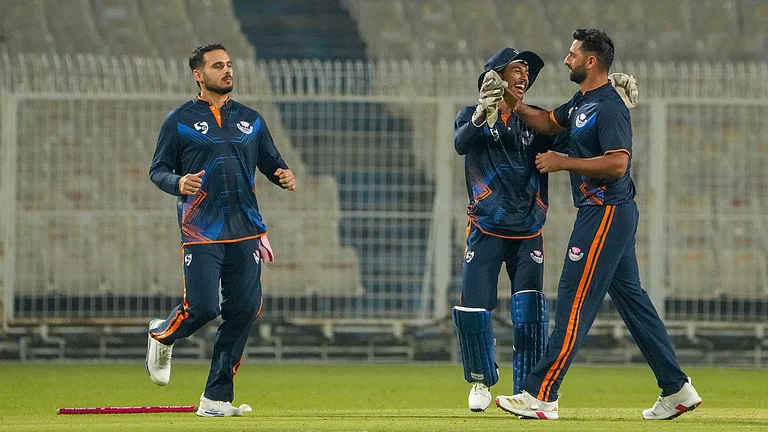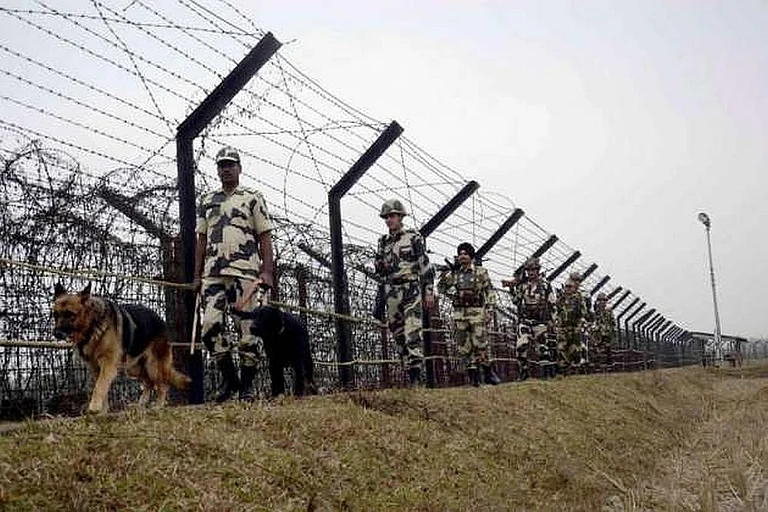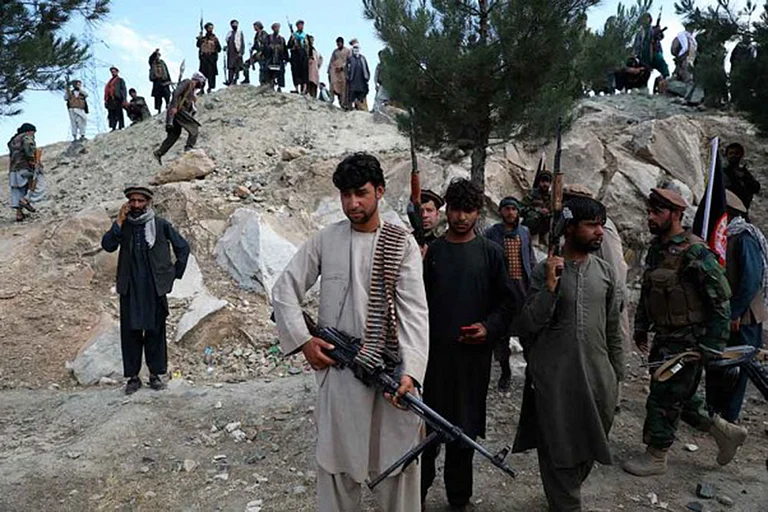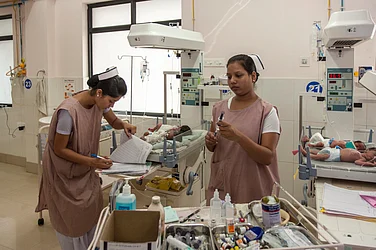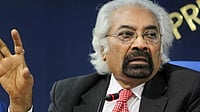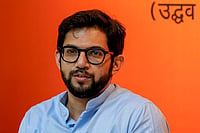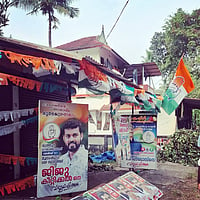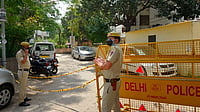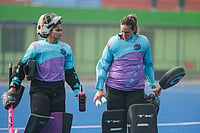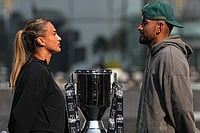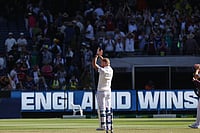The Kashmir region is often dubbed as one of the most militarised places in the world. Two nuclear powers, India and Pakistan, lay claim to the region and have been warring over it since their independence from the British in 1947.
Barely two months after Independence, Pakistani fighters invaded Jammu and Kashmir, leading to the first of four wars the two countries have since fought.
Around 48,000 people have died since 1988, according to data with the South Asia Terrorism Portal, when new terrorist groups began to emerge and crossings into Pakistan to train for armed movements against the Indian state increased.
However, the disturbance in Kashmir predates the late 1980s. Praveen Swami has outlined five phases of conflict in Kashmir in his book India, Pakistan and the Secret Jihad: The covert war in Kashmir, 1947-2004.
The first phase began with the India-Pakistan War of 1947-48. It was waged by small groups of Pakistan-backed covert operatives. Prime Minister Jawaharlal Nehru had called it an “informal war”.
The second phase between early 1960s and mid ‘60s was led by what was called “Master Cell”. The objective was to create conditions through their activities for a mass rebellion in Jammu and Kashmir.
The third phase during late 1960s to 1971 was led by another group known as Al-Fatah that ended by the 1971 war’s end.
The fourth phase following the 1971 war was led by the National Liberation Front with little institutional support from Pakistan whose energy was exhausted after its defeat in the 1971 War.
The fifth phase led to the events after 1989-90, leading to the most violent phase of the Kashmir conflict, which witnessed widespread terrorist activity, confrontation of locals with the security forces, allegations of human rights violations, and the migration of minority Kashmiri Pandit community in large numbers.
There were two earlier incidents as well. Before Independence, Sheikh Abdullah led a "land-to-the-tillers" movement from 1932, which was for land reforms in the state that he eventually carried out after becoming cheif minister post-Independence.
In 1947, Maharaja Hari Singh, anticipating Independence, dismissed his Muslim soldiers, mostly from Poonch. When they revolted, the Maharaja ordered his Dogra and Sikh troops to attack the Muslims of Poonch and adjoining districts of Jammu, killing several thousands, and driving lakhs towards what is now Gilgit Baltistan under Pakistan's control.
It's these villagers, along with some tribals, who had armed themselves and returned to reclaim their lands - who were described as Pakistani irregulars. Pakistan Army joined them, but later.
The hanging of Maqbool Butt
Maqbool Butt was the leader of first generation of Kashmir’s separatists and was associated with Jammu Kashmir Liberation Front. He was executed on 11 February 1984 after being sentenced to death by the Supreme Court. He was buried in Tihar Jail premises where he was hanged.
“Bhat was given the death sentence by the Supreme Court but had been abruptly executed to assuage public anger over the abduction and killing of Indian diplomat Ravindra Mahatre in the UK by an alleged affiliate of Bhat’s now-banned terrorist group, Jammu Kashmir Liberation Front (JKLF),” according to an article in The Print.
Since then, he has come to be known as Shahid-e-Kashmir among a section of people.
The turning point of 1987
The year 1987 is considered a turning point in Kashmir’s modern history when the state elections believed to be rigged in favour of the Congress-National Conference alliance led to mass alienation.
In 1987 elections, Jamaat-e-Islami and a number of Islamic groups came together to form Muslim United Front (MUF), whose grassroots movement attracted a lot of young voters. It was against any Indian government’s interference in Kashmiri affairs.
However, alleged rigging in the elections is believed to have caused MUF to lose up to 13 seats. Only four candidates contesting under its umbrella won. This led to great disgruntlement and alienation among the people, particularly the youth, who had sought MUF to channelise their discontent.
Addul Ghani Lone, the late Kashmiri separatist leader, had said the 1987 election motivated the younger generation to say "to hell with the democratic process" and "let's go with the armed struggle".
Lone said in an interview in 1994 cited by Sten Widmalm, "The thought was there, the motivation was there, the urge was there, the demand was there, and the opposition was there. The situation became ripe, and [the elections provided] a flash-point."
1987 produced a new wave of terrorists
Political science scholar Sten Widmalm has noted that several young activists engaged in the political opposition at the time decided to join the armed struggle after the 1987 elections that they believed were rigged.
Mohammed Yusuf Shah unsuccessfully contested the 1987 elections. He moved to armed movement following the results and went on to take up the name of Sayeed Salahuddin and become the leader of terrorist organisation Hizbul Mujahideen.
One of Shah’s aides, Yasin Malik, who was his election agent, would go on to become the leader of Jammu Kashmir Liberation Front and be one of the most notorious terrorists who is accused of murdering four Indian Air Force personnel.
The 1990s were marked by increased civilian deaths in Kashmir. Around 10,000 civilians died between 1988-2000 – more than double the number in the decades since.
Abduction of Western tourists, 1995
On 4 July 1995, four tourists, John Childs and Don Hutchings of US and Keith Mangan and Paul Wells of UK, were abducted in the Liddarwat area of Pahalgam in Anantnag by Al-Faran, a front of the now-defunct Harkat-ul-Ansar group.
Two more foreigners, Dirk Hasert of Germany and Hans Christian Ostro of Norway, were abducted on 8 July. While Childs abducted on 4 July managed to escape on 8 July, Ostro was beheaded.
The rest of the abducted tourists could never be traced and are beleived to have been killed.
IC 814 hijacking
Indian Airlines flight IC 814 was hijacked by Pakistan-backed operatives on 24 December 1999. The hijacked plane was taken to Kandahar in Taliban-controlled Afghanistan and was freed in lieu of three men's release from Indian prisons - Maulana Masood Azhar, Ahmed Omar Saeed Sheikh, and Mushtaq Ahmed Zargar.
Masood Azhar is now the Jaish-e-Mohammed chief responsible for Pulwama Attack and other terrorist activities. Following his release, Ahmed Omar Saeed Sheikh has been accused of killing American journalist Daniel Pearl.
Peace talks and derailment
Former Prime Minister Atal Bihari Vajpayee visited Lahore to meet Nawaz Sharif in February 1999, leading to the Lahore declaration, which sought to prepare ground for substantial initiatives for peace. However, this was derailed by the Kargil War within a few months.
Vajpayee met Pakistan’s President Parvez Musharraff in 2001 to start another phase of dialogue. An attack on legislature building in Srinagar and Indian parliament in Delhi followed and the process was again derailed.
Dialogue resumed in 2004 under which four rounds of talks were held but they were again derailed by the 2008 Mumbai terrorist attacks.
Kashmir under Narendra Modi
The Kashmir conflict had evolved by the time Narendra Modi became prime minister. Besides infiltration from Pakistan, there were incidents of stone-pelting and the Pakistani military was also getting aggressive at the border with its Border Action Team targeting Indian security forces personnel.
Two incidents that have proved to be turning points for Kashmir since were the killing of Burhan Wani and the Pulwama terrorist attack.
Burhan Wani’s killing and subsequent uprising
Burhan Wani was a popular militant leader who had built a large following through social media. His killing attracted large protests and plunged Kashmir into months of unrest as people organised protests after protests and clashed with the security forces.
Wani’s father said in an interview at the time that had he been arrested instead of being killed, the separatist movement would have suffered a great blow. But killing Burhan Wani gave it a fresh push, he said in an interview with David Devadas.
Wani’s death triggered an unrest where militants gained a foothold in the southern districts of Kashmir and motivated another generation of Kashmiris to take the violent path, according to Observer Research Foundation’s Khalid Shah. This generation is young, educated, and tech-savvy.
Evolution of Kashmir militancy from Pakistan-based to homegrown
The militancy in Kashmir has increasingly become homegrown in recent years. This has coincided with fall in infiltration from Pakistan and rise of a new terrorist group named The Resistance Front that seeks to rebrand the movement in Kashmir as homegrown instead of Pakistan-backed.
Vivek Chaddha, a research fellow at the Manohar Parrikar Institute of Defence Studies and Analysis, said in an interview in 2020 that TRF was a Pakistani attempt to project the insurgency as an indigenous movement rather than a Pakistan-fuelled movement.
There were also reports in 2020 that suggested a shortage of weapons with militants and terrorists in Kashmir.
Conflict continues after the abrogation of Article 370
Despite the abrogation of Article 370, terrorist activities have continued in Kashmir. These activities have now taken the form of targeted killings where police personnel, local councillors, and religious minorities in the Valley are targeted.
Last year, killings of Pandits and Sikhs in the Valley triggered a fresh wave of insecurity among the remaining religious minorities in the Valley and there were reports that some families even left in the wake of those killings.
There were also multiple attacks on local councillors and district-based council leaders.







